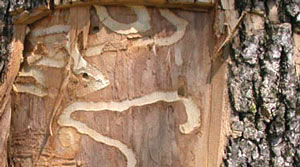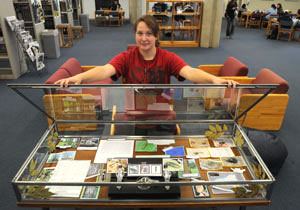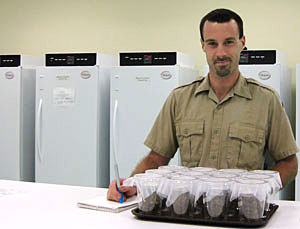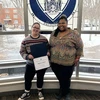|
|
The emerald ash borer, an invasive species branded the “Green Monster” that’s already turned up in nearby Cattaraugus County and carries the potential to devastate ash trees throughout the Eastern United States, is the subject of two displays in Reed Library at SUNY Fredonia.
Katie Walters, a junior Biology major who is actually from Randolph, created both displays for Museum Practicum, an upper-level course taught by Dr. Holly Lawson.
A primary goal of the display is make people aware that they can help limit migration of the emerald ash borer and other invasive species by adhering to regulations that restrict the transportation of firewood.
The U.S. Department of Agriculture is actively engaged in a campaign to limit the spread of the small but tiny beetle that was detected in 10 eastern states and parts of Canada in 2008, but has now spread to New York. Officials confirmed the presence of the insect in Randolph, N.Y., near the I-86 exit, in 2009. The emerald ash borer has already resulted in the death or decline of tens of millions of ash trees.
Native to China and eastern Asia, the emerald ash borer is believed to have entered the U.S. more than 10 years ago hidden inside of wood packing materials used in shipping. It was first detected in southeast Michigan in 2002.
SUNY Fredonia alumnus Jonathan Lelito, ’03, ’06, is studying this insect as a researcher with the U.S. Department of Agriculture. Dr. Lelito returned to campus on Friday, Oct. 15, to give a guest lecture to biology and other natural science majors and discuss his research and the devastating effects of the beetle. He was also profiled in the most recent edition of the Statement alumni magazine, which can be read here.
The library displays, located in the main floor, introduce purple wooden boxes that are being utilized in Chautauqua County to detect the beetle, if it’s already here.
Ways that people unknowingly contribute to the artificial spread of the beetle, such as by the transfer of firewood, nursery stock, green lumber and wood chips, are outlined. A variety of public awareness campaigns have been launched to encourage campers and others not to move firewood, to help lessen the spread of the infestation.
The library's displays include maps that depict specific areas where the beetles have been found, identify ways to identify ash trees and detect infestations, and steps that can be used to limit its migration.
The displays can be viewed through the end of October.






